
This Page
Photographer Sara Pace captures a snowy scene along Three-Mile Drive.
ON THE COVER
A winter solstice sunset between the



This Page
Photographer Sara Pace captures a snowy scene along Three-Mile Drive.
A winter solstice sunset between the

WINTER 2024, VOL. 43, NO. 6
Elise Bremer Editor
Brenda Drake Lesch Art Director
Andrew Gapinski Executive Director
Matthew Clark, Ph.D. Director of Research
Rachelle Crosby Director of Facilities & Project Management
Timothy S. Kenny Director of Education
Jared Rubinstein Director of Horticulture & Collections
David Senior Director of Business & Finance
Susan Taylor, Ph.D. Director of Advancement
Tom Lany Senior Marketing & Communications Manager
Kathy Persian President, Arboretum Foundation
Arboretum Magazine is published by the Minnesota Landscape Arboretum. The Arboretum is part of the College of Food, Agricultural and Natural Resource Sciences (CFANS) at the University of Minnesota. The magazine is a benefit of Arboretum membership. To request a copy of this publication in an alternate or digital format, please call 612-301-1257.
© 2024 Regents of the University of Minnesota. All rights reserved. The University of Minnesota is an equal opportunity educator and employer.
arb.umn.edu 612-624-2200
arbpr@umn.edu
Arboretum Magazine is printed on 100% sustainable recycled fiber paper.



As always, a new season brings a new issue of Arboretum Magazine! I’m jumping in to share a few key updates to the magazine that readers will discover in this issue.
We’ve added pages to the magazine allowing us to feature longer, more indepth stories to better connect members to the Arboretum community. We’ll continue to showcase timely horticulture information from Arboretum experts, plant breeding and research updates from the Horticultural Research Center and seasonal happenings and perspectives from across the Arboretum.


In terms of timing, we’re moving from bimonthly publication to a quarterly schedule, mailing in winter, spring, summer and fall and covering the key seasons of change and renewal at the Arboretum. By adding eight pages to each issue, we’ll be maintaining the same number of pages across the year while providing more thorough, high-quality content in each issue.
As an Arboretum, sustainability and conservation are at our core. That’s why we’ve also updated the paper the magazine is printed on to a 100% sustainable recycled fiber paper that’s also Forest Stewardship Council (FSC) certified.
Finally, we’ve given the magazine design a refresh to highlight the beauty of the Arboretum and to better align with the branding of the Arboretum and the University of Minnesota. Thank you for your support as a member of the Arboretum. I hope you enjoy the new issue!
Elise Bremer, Editor
Winter is a wonderful time to explore the Arboretum. With a spectacular autumn (and the planting of some 40,000 tulip bulbs) behind us, I’m looking forward to watching the next season unfold as winter transforms the landscape. As I finish my first full year as Executive Director, it’s also a time of reflection as I look back on the incredible year of growth and change we’ve experienced at the Arboretum and continue to look ahead to the future. To help us realize this exciting next chapter in the Arboretum’s history, we welcomed three new members to the leadership team this year.
David Senior, Director of Business & Finance, leads visitor experience and earned revenue operations — including the launch of our new cafe, Rootstock — and ensures the financial sustainability of our organization. Rachelle Crosby, Director of Facilities & Project Management, oversees the support and renewal of infrastructure and visitor amenities and planning and development of the campus. This will include a new entryway and AppleHouse in the coming years. Finally, Jared Rubinstein, Director of Horticulture & Collections, the newest addition to the team, is reinvigorating the Arboretum’s commitment to horticultural excellence and the stewardship of natural resources across our more than 1,200 acres.
David, Rachelle and Jared join our existing leadership team at an important time as we work with the entire Arboretum community to envision the future of our treasured institution. In the coming months, we are excited to embark on the development of the Arboretum’s 2025-2030 strategic plan to amplify our mission-critical impacts in plant research, conservation, education, collections and community.
This year, we welcomed a record-breaking 684,000 visitors to the Arboretum. As we continue to grow and advance as an organization, I’m grateful for the support and dedication of our staff, volunteers, trustees and members. Thank you!
Andrew Gapinski


At a time when most of us are digging out winter coats and boots from the back of the closet, it’s easy to forget the other creatures that spend their winters here at the Arboretum and in our backyards. Gardening to support local winter wildlife involves careful thought and planning, but what is beneficial to local fauna is often pleasing to gardeners as well.
Careful plant selection can turn an otherwise drab and uneventful time in the garden into a much anticipated season alive with color, texture and wildlife. Late-season flowers provide last-minute forage for pollinating insects, while berries that cling to frozen branches offer color and sustenance for a wide variety of overwintering animals. Though browsing deer and gnawing squirrels are often viewed as pests by gardeners,
this relationship need not be adversarial.
At the Arboretum, the Johanna Frerichs Garden for Wildlife — located along Three-Mile Drive and Walk — demonstrates a variety of ways gardeners can landscape throughout the seasons with wildlife habitat in mind. Birds, insects, reptiles and mammals can all utilize these garden spaces for food, shelter, nesting habitat and more. In addition to showcasing pollinator beds, boulder walls, brush piles and water features, the garden features a variety of plants carefully selected by horticulture staff to attract numerous wildlife species throughout their life cycles. Look for the following beautiful and beneficial trees and shrubs on your next walk through the Garden for Wildlife.
Careful plant selection can turn an otherwise drab and uneventful time in the garden into a much anticipated season alive with color, texture and wildlife.
At a time of year when most flowers are long forgotten, the American witch hazel truly shines. The long, spindly petals of its spider-like blooms provide a striking yellow-to-orange display that lights up the landscape from late fall to early winter. They also emit a subtle fragrance, keeping winter environments both beautiful and aromatic. These late-blooming shrubs provide an excellent source of nectar for pollinating insects at a time when other food is scarce.
Often found in the understory of deciduous forests, these shrubs range in height from 12-25 feet making them suitable for the home landscape on a site that receives a mixture of sun and shade. Find American witch hazel in the Garden for Wildlife, the Wildflower Garden and around the Snyder Building’s Tea Room Terrace.


Another excellent source of vivid color in what otherwise tends to be a monochromatic season is winterberry. This deciduous shrub loses its leaves in winter, but its iconic bright red berries provide both vibrant color and a vital source of food for birds in the winter months. Robins, cedar waxwings and chickadees are among the overwintering species that benefit from these colorful winter treats.
Additionally, winterberry’s thick summer foliage provides excellent cover and nesting locations, meaning this shrub provides yearround benefits for many a feathered friend. Minnesota is at the extreme western edge of this plant’s native range, so it’s not a particularly common sight. It is typically found in wet forests or on the edges of wetlands where plants can range from 5-20 feet tall.
Winterberry is a dioecious plant, meaning individual plants will be either male or female. For plants to bear fruit, gardeners need to plant female plants along with their male counterparts. Find winterberry in the Garden for Wildlife as well as along the Bog Boardwalk and the Winterberry Collection behind the Dahlia Trial Garden.
Corylus americana
American hazelnut is known for its interesting catkins, which are long, pendulous flowers that appear in late winter to early spring. These catkins add texture and visual interest to the winter landscape and provide food for turkeys and grouse. The hazelnuts produced by this shrub have a soft outer casing with up to five nuts in each cluster. The nuts attract a variety of foragers, including blue jays, woodpeckers, chipmunks and squirrels.
Hazelnut is a versatile plant, tolerating a wide variety of soil textures and moisture levels. As a shrub or a tree, this species can range in height from 4-16 feet depending on soil and light conditions. While it won’t thrive in complete shade, it will tolerate anything between partial shade and full sunlight. Visitors can find American hazelnuts in the Garden for Wildlife and the Foodscape at the Farm at the Arb.


Cornus sericea
This shrub can thrive in dense and poorly drained soil, making it an ideal choice for that wet spot in the garden where other plants struggle, though it will require plenty of sunshine. True to the name, the young stems are bright red throughout the year and provide striking contrast against a snowy backdrop.
Deer, moose, rabbits and chipmunks will also browse on these stems throughout the wintertime. While many gardeners might cringe at the thought of deer perusing their shrubs, the damage done to dogwoods can be easily rectified with a bit of early spring pruning. Unlike evergreens that will suffer long-term defoliation, periodic pruning and browsing by deer will help dogwoods develop a robust, bushy shape that provides dense cover for wildlife.
Ruffed grouse, wild turkey and gray catbird can all be seen eating the white berries produced by this shrub during fall and winter months. Find red osier dogwood in the Garden for Wildlife as well as around the Trex Deck and in the Bailey Shrub Walk.
Matt Schuth l Naturalist
The American crow is considered to be one of the most intelligent and adaptable creatures on the planet. Traditionally, Native Americans believed crows to be symbols of wisdom and good luck, and they are often associated with intelligence, adaptability and teamwork. The concept of crows as symbols of death came from the superstitions of the European Middle Ages.
In Minnesota, crows have one brood per year, with the young from previous years staying to help feed the new brood. The young may stay with their parents for up to four years, as these smart and self-aware creatures take time to learn from their parents. Crows can learn to mimic human words and engage in creative play such as sliding down embankments, pulling mammal tails or provoking other birds to chase them. Whenever a flock of crows is making a raucous racket, they are likely pestering an owl in an activity known as “mobbing.”

Matt Schuth is a naturalist and author of “Nature at Our Doorstep.” He has contributed a nature column to Arboretum Magazine for more than 30 years and hosts seasonal guided “Walks With Matt” exploring the natural world at the Arboretum.

In wintertime, crows will flock together by the thousands. At Elliot Park and Loring Park in Minneapolis, 10,000 crows roost nightly. They congregate in huge flocks to protect themselves from predators and to maintain their tight-knit social bonds. In the daytime, they will spread out as far as 30 miles wide in search of food. In the mid-20th century, the large roosting flocks of crows were the target of wide-spread extermination efforts, but in reality, crows do much more good than harm.
A family of crows can eat 40,000 grubs, caterpillars, armyworms and other insect pests in one nesting season. They are omnivorous and a main part of their diet is roadkill, making them excellent natural recyclers. Similar to blue jays, crows have a special pouch in their mouth that allows them to transport and store food, and like raptors, they expel undigested pellets.
Crows can be seen and heard at the Farm at the Arb, at the forest edges along the BennettJohnson Prairie and at Lake Tamarack.

Anew solar array has come to the Farm at the Arb that will generate one-fourth of the farm’s energy needs each year, equivalent to powering five average Minnesota homes — thanks to a local business with a robust record of supporting the Arboretum.
The business is the familyowned Ziegler Companies, which provides client infrastructure such as construction, agricultural and energy equipment.
“We wanted to help the Arboretum progress in an increasingly renewable world,” said William Hoeft, president of Ziegler and third-generation family member. “One of our companies is Ziegler Energy Solutions, so it made sense for us to honor our legacy at the Arboretum in a modern way through the solar array.”
The company is a leader in the energy
transition and provides its clients with innovative energy solutions such as the solar array that now sits atop the Tashjian Bee and Pollinator Discovery Center at the Farm at the Arb. Through this gift, the company hopes to highlight solar as a renewable energy source and promote sustainability practices in addition to reducing energy consumption and minimizing Arboretum expenses for years to come.
The family’s involvement with the Arboretum can be traced as far back as Hoeft’s grandfather, Leonard Hoeft, who was Ziegler CEO and served on the Arboretum’s Board of Trustees. In 2001, he coordinated the in-kind resources of several contractors — that’s a lot of coordination — to repave Three-Mile Drive. Leonard and his wife Mary Lou also paved what is now Peter C. Moe Drive — formerly Eastern Drive —
Perched atop the Arboretum’s Tashjian Bee and Pollinator Discovery Center, a new solar array given by Ziegler Energy Solutions will provide one-fourth of the energy used by the Farm at the Arb each year. Photo by Phil Zumsteg
which leads to the Farm at the Arb, and donated a backup generator during the Visitor Center capital campaign.
That generator lives yet. When last summer’s Taste & Toast event had to move inside because of storms, compounded by a power outage, those attending didn’t have to squint to see the food, thanks to Ziegler.
It’s not just Ziegler that goes way back at the Arboretum. Hoeft remembers coming there even as a child with his grandparents: “It was, and is, this magical place. Once you experience it, it will always be a part of you. It sets the national standard for arboretums.”
Elise Bremer l Editor
Winter Lights is back at the Arboretum! Lighting up the gardens again this season, the one-mile walking tour celebrates the horticultural history of the Arboretum and invites visitors to get out and explore the gardens even in the darkest months.
Beginning with the iconic larger-thanlife walk-through apple that greets visitors behind the Snyder Building, the light displays throughout Winter Lights pay homage to the cold-hardy plant breeding research of the Arboretum and Horticultural Research Center (HRC).
“We always have a botanical theme,” said Wendy Composto, Signature Seasonal Events Manager and the creative vision behind the annual light displays. “When we started Winter Lights, we looked at the cold-hardy plants developed by the Arboretum
and the HRC and how we could highlight them.”
The glimmering red apple that kicks off the tour celebrated the 100th anniversary of the Haralson in 2022, proving that this University of Minnesota-developed apple — and the Arboretum visitors who pose underneath its light-up representation — are certainly cold hardy!
Other plants developed at the HRC for Minnesota’s cold climate get their time to shine at Winter Lights, too. Around the Wedding Tower

Using a tripod and combining long exposure with ICM (Intentional Camera Movement) techniques, photographer Todd Mulvihill captures the magic of the Winter Lights displays including the 16-foot Weeping Willow (bottom left) and butterfly wing photo station.

overlooking the Knot Garden, rows of illuminated roses grow up from the snow creating a magical winter garden beloved by visitors. Which of the four super-hardy Northern Accents® shrub roses or other University of Minnesota-developed roses they might depict is up to visitors to decide.
While some beloved light displays return to Winter Lights year after year, Composto adds a few new elements each season to surprise visitors. New this year, a woodland scene featuring glowing campfires, tents and forest creatures will inspire visitors of
Visitors, including all members, must reserve advance tickets for Winter Lights, including special theme nights. Learn more and get tickets at arb.umn.edu/winterlights.

all ages to explore the great outdoors, no matter the season.
Preparations for the walking tour begin in early September, with staff and volunteers placing the majority of the lights around the grounds before the snow flies and winter sets in.
Arboretum trees wrapped with lights are carefully decorated in consultation with horticulture staff, ensuring the health of the trees and the safety of staff and volunteers.
For those interested in recreating the Winter Lights experience in their own yards, Arborist Ian Vaughan stresses the importance of taking down lights at the
end of the season to ensure tree health.
“For any winter lights on trees, the biggest takeaway is the prompt removal of the lights after the winter or season. If strands of lights are left wrapped tightly around branches or the main trunk, they have the potential to girdle the tree and reduce the flow of water and nutrients,” said Vaughan.
Opening Nov. 21 and running select nights through Jan. 5, visitors can tailor their Winter Lights experience at curated special theme nights. For those visiting with small children, Family Nights on Nov. 26 and Dec. 19 feature smaller crowds plus hot cocoa, cookies
and a craft project indoors to warm up after touring the lights. Date Nights on Dec. 5 and 12 make for a romantic evening under the stars followed by dancing lessons indoors led by Costa Rica Ballroom.
All nights of Winter Lights feature s’mores kits for sale to roast over bonfires at S’Mores Village, plus food and beverage options for sale indoors at Rootstock.
Don’t miss the magic of Winter Lights, lighting up the nights at the Arboretum all season long. Said Composto, “Lights just brighten your spirits; they brighten the night and we need that in the winter.”

The University of Minnesota’s Horticultural Research Center is well known for developing coldhardy versions of beloved landscape plants including azaleas, but without consistently cold winters, the dynamics are shifting, and researchers are learning to adapt.
As Minnesota’s winter chills become increasingly unpredictable, even the hardiest Minnesotans find their frosty routines thrown off balance. With the state’s winter cold no longer reliably harsh, plants in our region are now facing a new test of their resilience, too.
Researchers at the University of Minnesota’s Horticultural Research Center (HRC) understand that plant cold hardiness requires so much more than the ability to withstand subzero temperatures in the face of climate change. That’s why researchers are now complementing the center’s long history of cold-hardy plant breeding with efforts to understand how these plants respond to the new normal of fluctuating temperatures in the spring, fall and throughout the winter.
Historically, Minnesota's harsh winters served as a natural filter, ensuring that only the hardiest plants could thrive. However, milder and less consistent winters have disrupted this natural selection process.
According to Steve McNamara, a researcher at the University of Minnesota’s Department of Horticultural Science, the warming of Minnesota’s winters at an unprecedented rate is not just a matter of warmer temperatures; it’s altering plant survival and growth dynamics. “As climate changes, if it impacts the composition of plant species that we’re capable of growing here, that’s going to have pretty serious impacts on the whole ecosystem,” said McNamara.
“The real challenge comes from the fluctuation, so my biggest concern is more frequent extreme weather events,” said Brandon Miller, an assistant
professor and Curator of Plant Collections at the Arboretum. His work focuses on identifying underutilized plant species that are cold hardy and suited to future climate conditions. “We need to identify and utilize resilient plant species that can tolerate both extremes, which is a tall order.”
Periods of thaw in late winter can interrupt plant dormancy, or the period in which plants stop or slow growth during the winter to preserve energy and protect soft tissues from freezing. In early spring, plants rely on a steady cold period to remain dormant and are vulnerable to damage when temperatures rise unexpectedly. These fluctuating temperatures can reduce cold hardiness and increase susceptibility to damage from spring frosts if plants grow too soon.
Autumn temperature swings can be equally harmful. Plants that have not yet adapted to these cooler conditions may suffer, impacting their growth and survival. The challenge for researchers is to develop plant varieties that can handle these new, unpredictable conditions.
“It will be important to identify and breed plants that can avoid de-acclimating (or losing hardiness) in response to periods of above-freezing temperatures in winter, which would render them vulnerable to injury when temperatures decrease again,” said McNamara. This ongoing research aims to develop plants that can withstand both the current climate and the uncertainties of future weather patterns.
Time is a critical consideration when researching plant and tree resilience to climate change. Perennial plants and trees, with their long lifespans, present a unique challenge for researchers. Many species' slow growth and extended life cycles mean that results often take decades to materialize. To address this,
experts at the Arboretum and HRC are employing a combination of innovative tools and techniques.
McNamara and Miller use several methods in their research to aid in breeding plants that can handle a changing climate. Environmental chambers mimic different temperature conditions allowing researchers to observe how plants adjust to changing temperatures. Photosynthesis meters and osmometers measure how plants react to drought and heat, providing vital information about water loss and plant stress. After exposing plants to cold conditions, researchers study plant damage under a microscope to determine the lower ranges of a plant’s hardiness.
Utilizing these techniques to develop highthroughput screening systems — advanced technologies used to screen many plants simultaneously for tolerance to heat or cold — will allow McNamara to identify plant material that can be used to breed more resilient plants. McNamara said his work with other groups including the Plant Collecting Collaborative and other researchers at the Arboretum helps him access a wide range of plant material and share valuable research findings.
Historical plant records from the Arboretum allow Miller to guide the evaluation of previously trialed species and identify those with potential for future use.
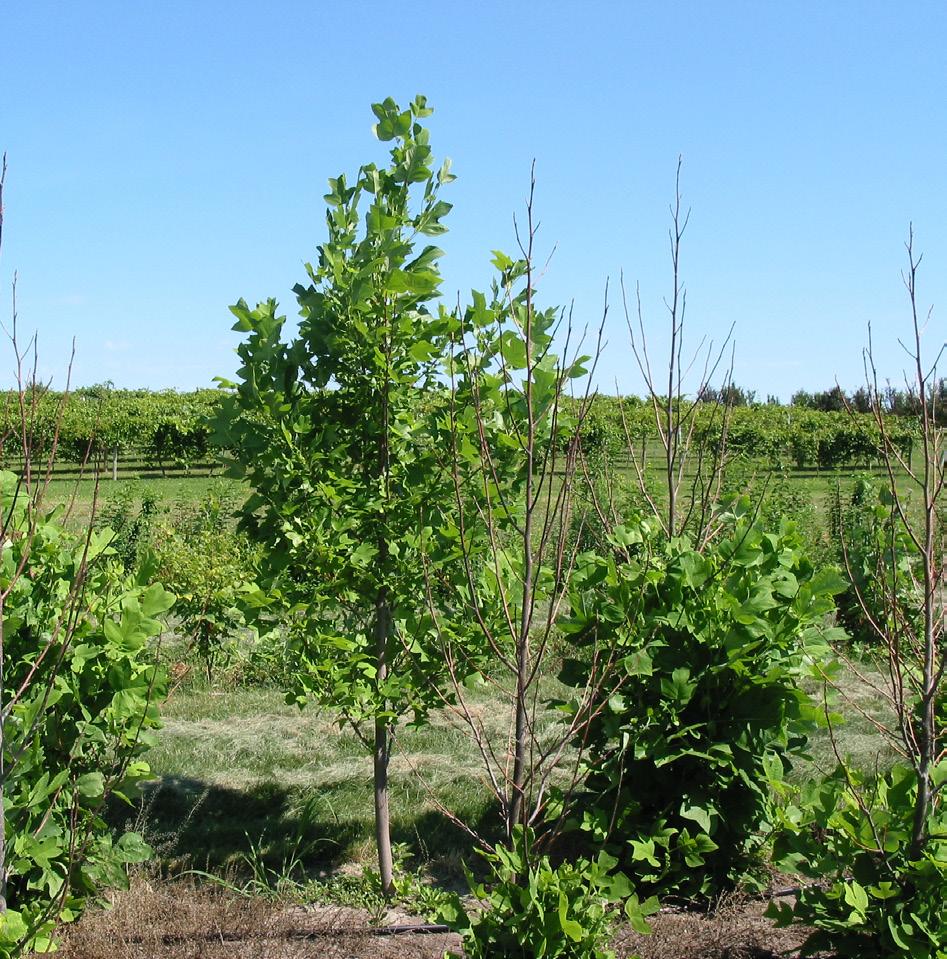
His Resilient Landscape Project focuses on discovering underutilized plant species that can thrive under extreme weather conditions and changing climate scenarios, aiming to enhance plant diversity to combat weather extremes and pest pressures. Through the Urban Tree Diversity Education Project, funded by the USDA Forest Service, Miller creates resources and provides hands-on training to urban and underserved communities on best practices for plant selection.
McNamara and Miller also collaborate with experts in other cold-climate states, including North Dakota, Iowa and New York. “We also have collaborators in warmer zones, in places like Georgia and Louisiana,” said Miller. “Working with a broad range of collaborators with different goals and perspectives provides useful information for our regional needs.”
As plants in our region adapt to these changes, so must the researchers, working tirelessly to understand and mitigate the far-reaching implications of a shifting environment before it’s too late. According to McNamara, “If a warming climate changes the plant species that can survive in Minnesota, favoring those that tolerate hotter and drier conditions, it will certainly impact other parts of the ecosystem, including insects, mammals and other populations dependent on current species for food and shelter.”


1. Tulip poplar seedlings in a field trial conducted at the HRC display various degrees of injury or relative cold tolerance. Photo by Steve McNamara
2. A frozen Actinidia arguta (kiwiberry) stem sample following a nitrogen bath used to determine total relative electrolyte leakage for cold hardiness assessment. Photo by Seth Wannemuehler
3. A kiwiberry seedling cold hardiness evaluation plot covered in snow. Photo by Seth Wannemuehler
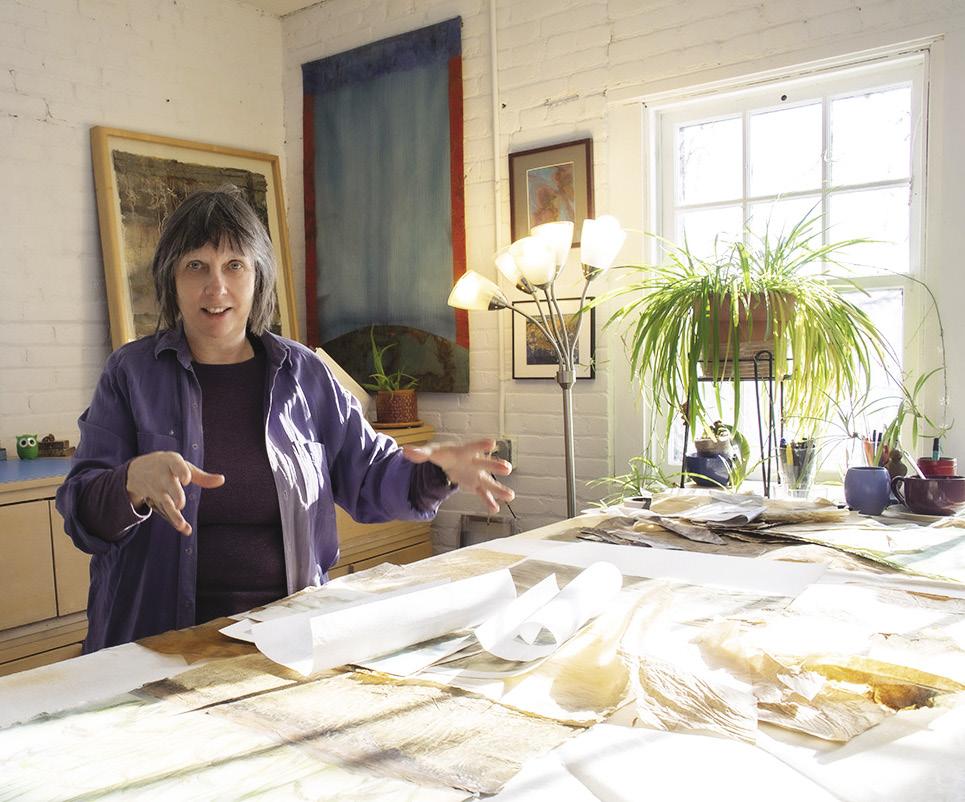
Deborah Foutch presents dramatic pieces inspired by ecology, geology and hope
It seems only natural that Deborah Foutch would choose fiber arts as her medium of choice for her art.
“Both my grandmothers taught me to sew,” she said. “This is like home to me. My hands like it.”
However, while she pursued an art and history double major at the University of Northern Iowa, she struggled to find her way, especially with painting. Indeed, it wasn’t until a fiber arts program started up at the college that she found her lifelong path.
“It didn’t occur to me that I could make art from fiber,” she said. “I went from doing mediocre paintings to doing big fiber installations. If you walked into a room and saw my work, you were impacted.”
Arboretum visitors will get to experience the impact of Foutch’s latest work with her solo show: “Unraveling: A Fiber Art Exploration of Our Natural
South Minneapolis mixed media artist Deborah Foutch will present an art show — “Unraveling: A Fiber Art Exploration of Our Natural World” — Jan. 15- Feb. 16, 2025. Photo courtesy of Deborah Foutch
World” on display in the Reedy Gallery Jan. 15-Feb. 16, 2025.
Foutch’s connection to the natural world goes back to her childhood. As the daughter of a soil conservationist, she was aware of how important it was to protect fertile soil, and was always excited when reading the new science about what makes soil productive, including billions of organisms that can populate a single handful of healthy earth.
“In my father’s time, soil was a growing medium,” she said. “Now we understand it's a living system.”
Today, Foutch’s work explores that system and what holds it together — or doesn’t.
“Modern agriculture is killing soil at a stupendous rate,” Foutch said, adding that her research for her art led her to explore Earth’s geology and ecology, further fueling her inspiration. In the
face of declining soil health, she also went looking for hope — and found it — in books about planethealing strategies, including regenerative agriculture.
Using cotton, canvas, silk, papers, organza and more, Foutch creates intricate, cross-section views not just of soil systems, but also of plants above ground attached to their realistic root systems below.
Foutch has lived in south Minneapolis since 1980 and has become a sought-after artist during the past 40 years, showing her work in galleries, both locally and nationally. She’s also a perennial favorite in the Fine Arts Competition at the Minnesota State Fair, where she’s won several awards.
Find more information about this show and all upcoming exhibitions at arb.umn.edu/art.

Derek Carwood l Adult Education Manager
The popularity of gardening has soared in recent years, and with it, the desire for accessible horticulture education from knowledgeable experts. ProHort is a comprehensive horticulture foundation course offered through the Arboretum and designed by the University of Minnesota Extension with the same classes provided through the Master Gardener program.
The newly revamped program — which opened for registration in the fall — delivers a learning experience unmatched
by other organizations in the Upper Midwest at a cost that falls well below industry standards. This makes it an ideal program for industry professionals, homeowners, educators and even lifelong gardeners seeking to enhance their horticulture knowledge.
ProHort’s online learning platform and thoughtfully structured course modules make the program an accessible and comprehensive choice for those
Siana Goodwin, a 2024 ProHort participant, joined the program to deepen her horticulture knowledge and better her understanding of the plants growing right in her backyard.
Below Right This year, each ProHort registrant will receive a printed copy of the Horticulture Core Course Companion Guide, previously offered as an optional upgrade to the included digital guide.
interested in deepening their gardening and horticulture knowledge.
Siana Goodwin, a participant enrolled in the 2024 ProHort cohort, found that the program was exactly what she was looking for to jump-start her journey in her own garden. “I wanted to learn more about plants, gardening and soils, and this was a very convenient way to do it,” she said. The program’s organization and logical sequence of topics made it easy for her to follow along at her own pace and truly understand the materials.
Although ProHort is a self-guided online learning experience taught through the University’s Canvas platform, the program also offers materials in a wide variety of channels making the content engaging and approachable for a variety of learning styles. In Goodwin’s words, “It is very thorough and has a lot of information. There were texts, movies and articles and the Q&As were great! In fact, the Q&As were my favorite part.” New this year, all students will receive a printed copy of the Horticulture Core Course Companion Guide — in addition to a digital guide — upon registration. Another program highlight is the opportunity for hands-on learning and field trips to the Arboretum — the
perfect place for students to explore the gardens and experience the horticulture principles they learn about in the program first hand. Students enrolled in ProHort also have access to mentors, providing a deeper connection through one-on-one interactions.
The course not only equips participants like Goodwin with practical gardening skills but can also spark new interests and aspirations. For Goodwin, ProHort ignited a passion for creating a pollinator sanctuary in her yard. Through the course, she learned more about what plants thrive in different conditions, such as sun and shade, and gained a better understanding of soil composition.
“Lately, I’ve become much more interested in the soil. Because of my experience with ProHort, I am actually thinking about going back to school for soil science!”
One of the advantages of ProHort is its flexible schedule, which makes the course accessible to those with fulltime jobs and busy schedules. Unlike the pressure to keep up with a collegelevel course schedule, ProHort allows participants to learn at their own pace. “It is not as demanding as trying to pass an exam at a university course, which is good! I felt confident to be able to get through it,” said Goodwin.
Siana Goodwin, a participant enrolled in the 2024 ProHort cohort, found that the program was exactly what she was looking for to jump-start her journey in her own garden. “I wanted to learn more about plants, gardening and soils, and this was a very convenient way to do it,” she said.

Participants can look forward to a course that continues to evolve based on participant feedback and the changing needs of the community, ensuring that the content stays relevant and is up-todate with the latest gardening trends and knowledge. This year’s standard inclusion of the printed Core Course manual with the purchase of the class is one such update aimed at enhancing the learning experience.
As the gardening community continues to grow, ProHort stands out as an approachable, high-quality course that inspires burgeoning horticulturists to cultivate not only their gardens but also their understanding of and passion for the natural world.
When asked if she would recommend ProHort to others, Goodwin’s endorsement was glowing: “Yes, yes I would!”
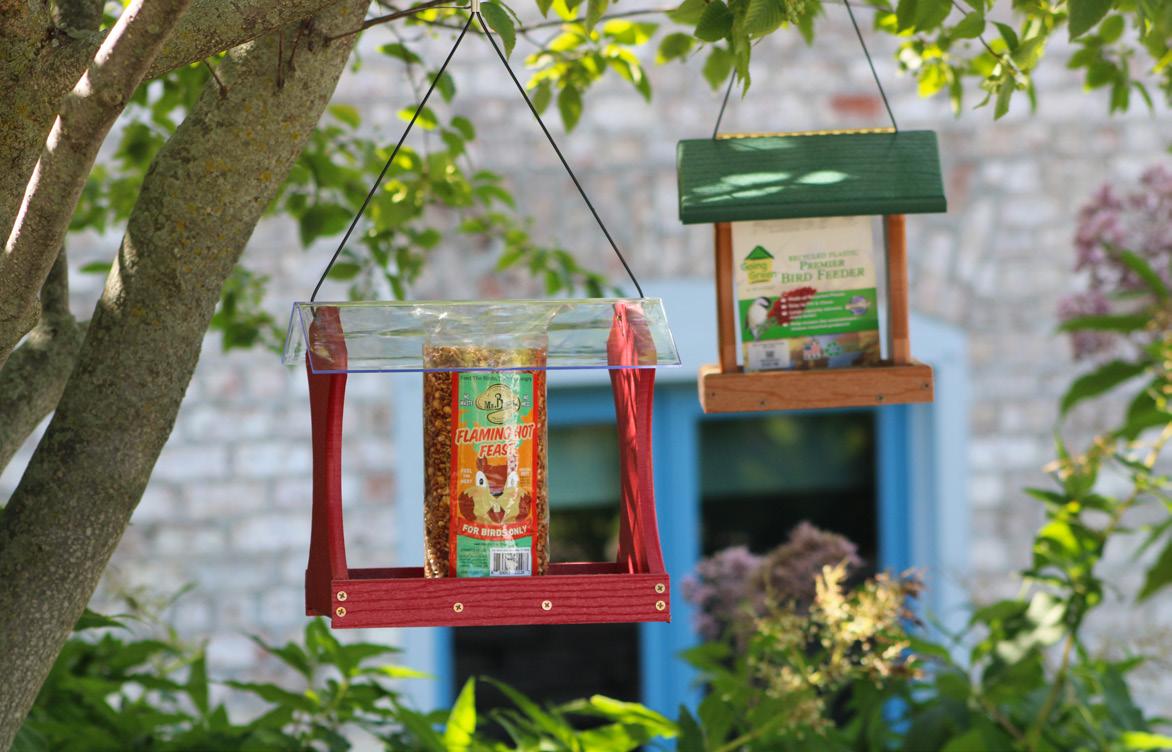
Give the gift of nature this holiday season!
An Arboretum membership provides year-round access to the leading northern landscape arboretum, featuring more than 1,200 acres of gardens, natural areas and miles of hiking trails.
Membership to the Arboretum includes:
• Arboretum admission for an entire year
• Year-round free events and activities
• Special discounts to Arboretum classes
• Early ticket access to signature events including Taste & Toast and Winter Lights
• Subscription to Arboretum Magazine
In addition to providing access to the Arboretum, memberships help maintain the stunning landscapes at the Arboretum and support plant research and local and global conservation efforts. Purchase a gift membership by calling 612-301-1257 or visit arb.umn.edu/support/membership
Shop indoor gardening gifts including terrariums, soils, fairy garden accessories and books for plant lovers at the Gift & Garden Store. Find the perfect gifts for nature lovers, Arboretum explorers, gardeners and lifelong learners
For those who can’t pass by the living room window without pausing to watch the birds, the Gift & Garden Store has a curated selection of bird feeders, seed and bird-themed gifts to attract birds all winter long.
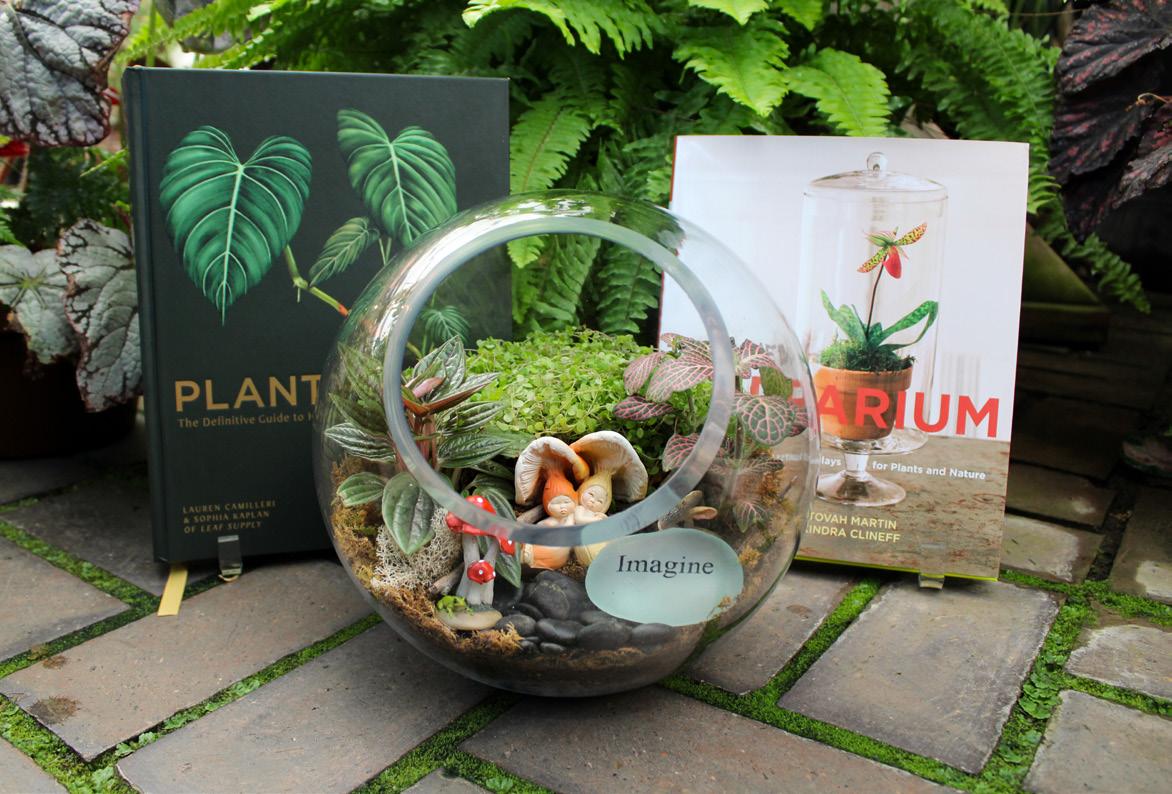
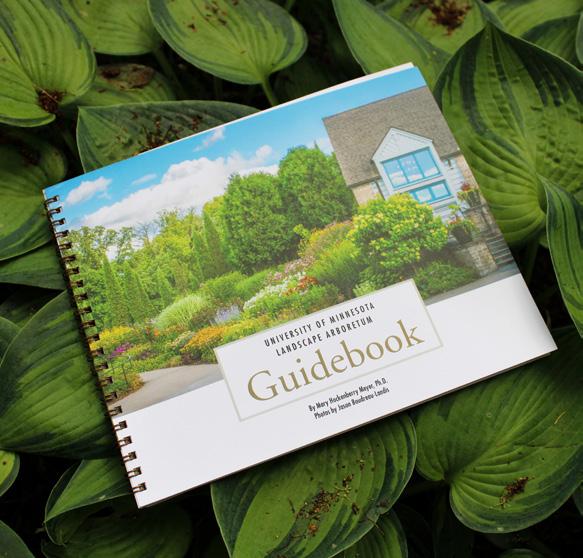
Gift the new 50-page, spiral-bound Arboretum Guidebook now for sale in the Gift & Garden Store for $12.99. Member discounts apply! This book is an incredibly useful resource that includes seven maps and seven tours geared toward out-and-about families, avid gardeners, art lovers, nature lovers and more.
Located just 1.5 miles west of the Arboretum’s main entrance, the AppleHouse transforms into a Holiday Boutique in early November and features a wide variety of apple-themed fare including frozen pies and strudels and gourmet gifts. No reservation is required and members receive a 10% discount.

Have you ever wondered how to honor a loved one with a brick, tree, bench or even a garden at the Arboretum? These are gifts that keep on giving for generations to come. Learn more at arb.umn.edu/memorials
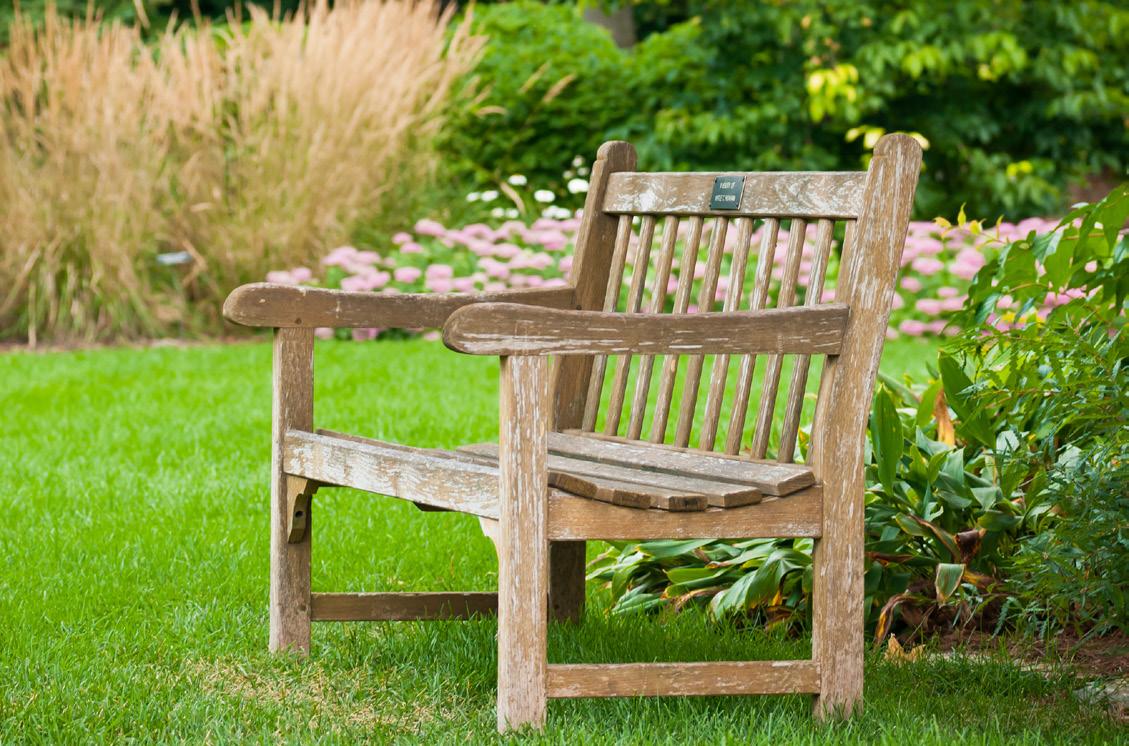
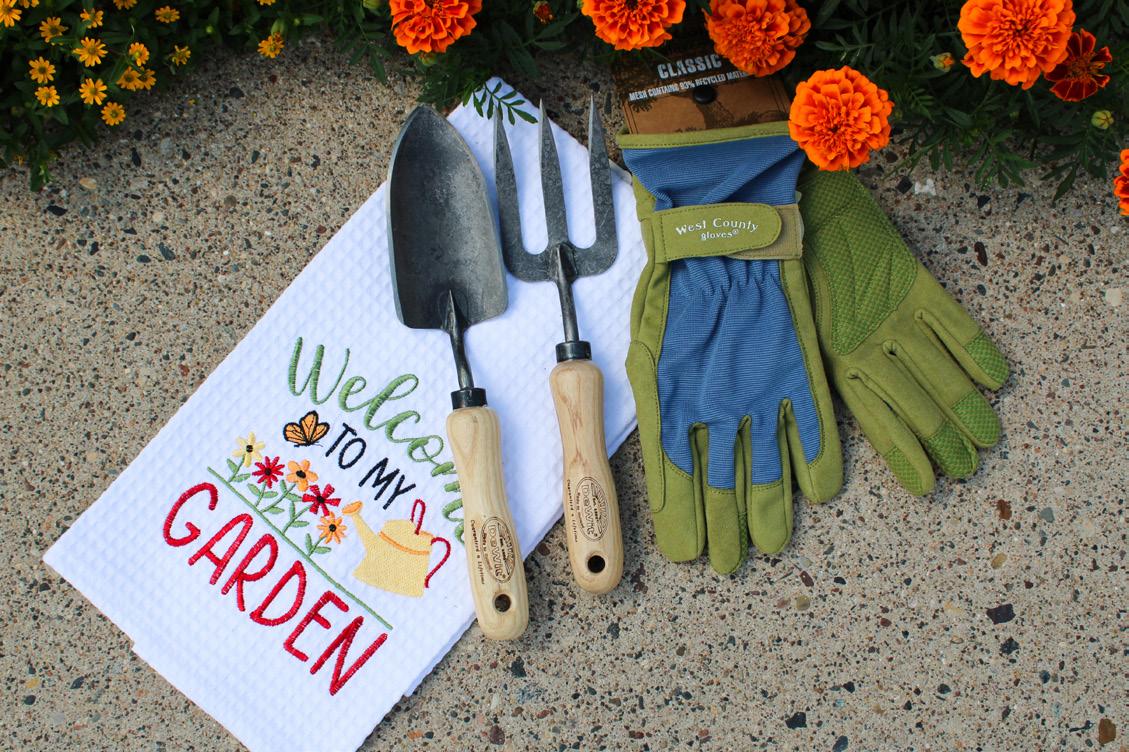
Help the green thumb in your life recreate their own patch of the Arboretum’s gardens at home, with garden gifts from the Gift & Garden Store including DeWit and Felco tools, gloves and decorative garden art.
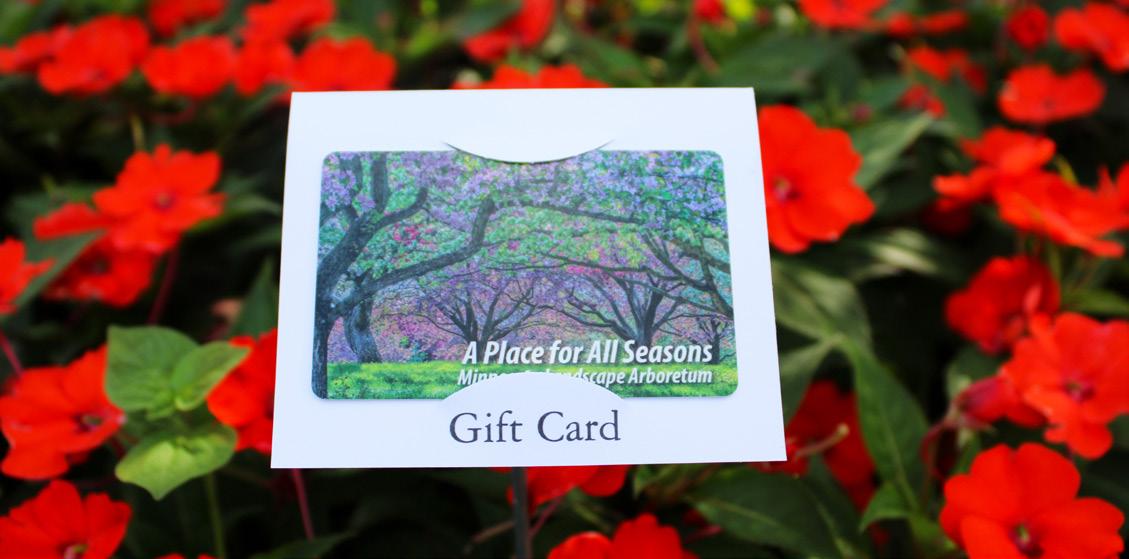
Need a last-minute or anytime gift idea? How about an Arboretum gift card? Gift cards — available at the Gift & Garden Store and AppleHouse — are accepted throughout the Arboretum, including the Gift & Garden Store, AppleHouse and Holiday Boutique, Rootstock and for event or admission tickets by calling 612-6242200. Gift cards can be redeemed for classes by calling 612-301-1210 or by emailing arbedu@umn.edu
Nancy Teske has been an Arboretum member for about 25 years. Three years ago, Teske joined Arboretum staff as an integral part of the Membership team.
What was your first experience of the Arboretum?
Exploring the trails with no phone, just the sounds of nature, lent a certain sense of safety that I didn't feel I could get elsewhere. Those walks in the woods were incredibly therapeutic and life-giving during some hard times.
The Arboretum holds extra special meaning for you. Tell us more!
My husband Thad and I had our first date here, and on Dec. 31, 2009 — my birthday — he proposed here! We snowshoed to an undisclosed location where he popped the question! The following spring we had our wedding reception here and cherish some incredible one-of-a-kind photos.
Also, at the entrance to the Maze Garden we have a memorial brick for my dad, which was gifted to me by a group of friends when he passed away in 2014.

My mom, who was Dutch, enjoyed visits to see our legendary tulips.
At just about every turn on these incredible grounds is another memory I hold dear. So it only seemed right and logical that one day I'd work here!
What are your favorite spots at the Arboretum?
My go-to places are the Peony Walk, the Pine Collection, walking Three-Mile Walk or the East Side Trails. I’ve been spending more time out at the Farm at the Arb, too!
What’s your role at the Arboretum?
I’ve been part of the super talented and wonderful Membership team for three years. I really enjoy talking to our long-time members but especially to the first-timers. The excitement and anticipation of discovery is so fun to witness. It’s easy to share and promote what I love!


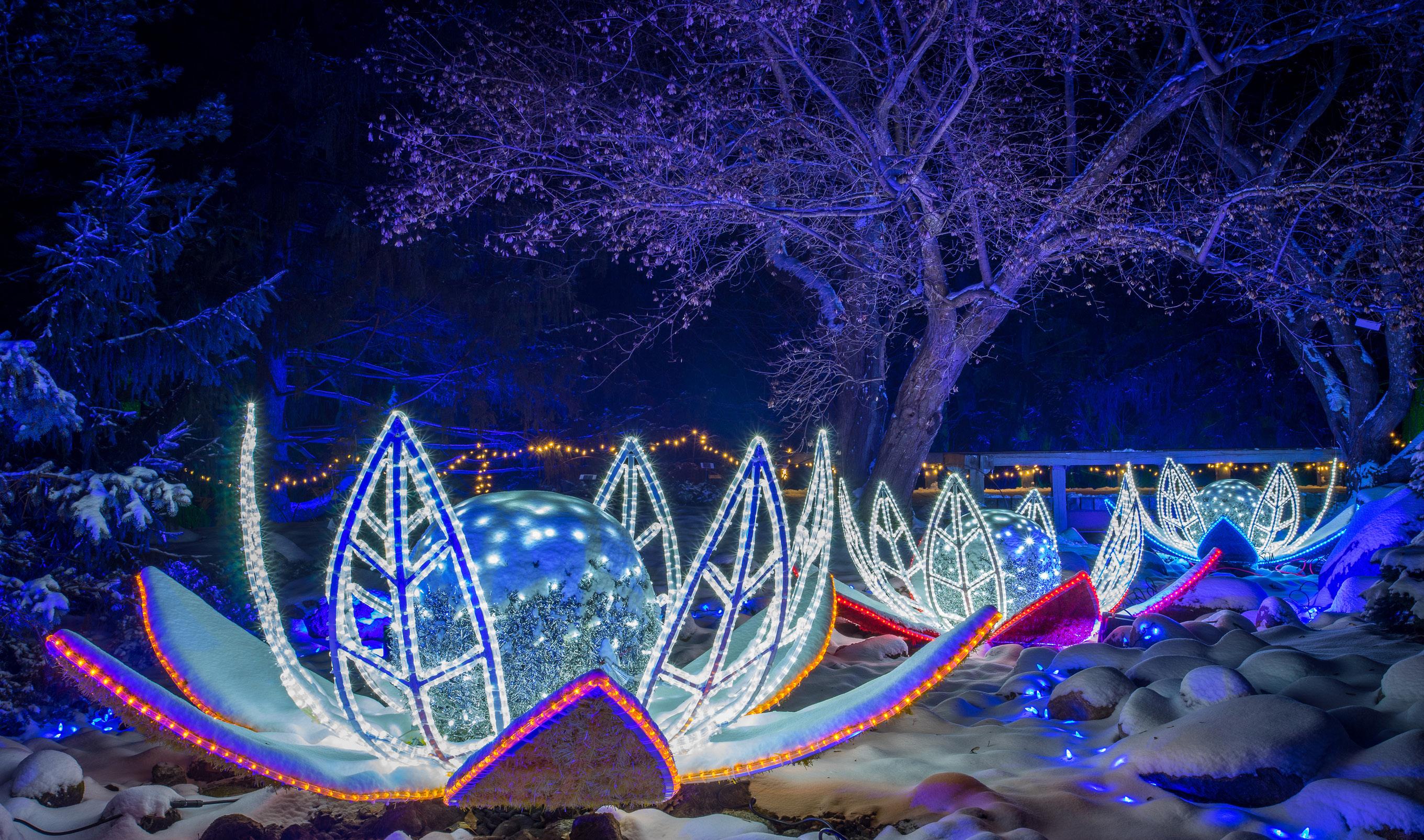
Open daily
Reserve tickets online!
Visit the Arboretum’s new dining experience! Led by Arboretum Culinary Lead Beth Fisher and Executive Chef Niki Heber, Rootstock offers quality, farm-fresh dishes that are plant-forward and meat-supported.
Stop into Rootstock on your next visit to the Arboretum for a cup of hot soup, a break from chilly winter weather and to enjoy the company of friends.

Open select evenings Nov. 21-Jan. 5
Experience the magic of winter at the Arboretum as you stroll through the gardens illuminated with light displays highlighting flowers, trees and the beauty of nature on a one-mile self-guided walk. Visitors, including all members, must reserve tickets for Winter Lights. Find all available dates and times and reserve tickets online
For a curated experience, check out Winter Lights special theme nights. These events feature a smaller capacity and allow visitors to explore the light displays with plenty of photo opportunities before heading inside for themed activities.
Opening Night Celebration
Nov. 21, 6-9 p.m.
Date Nights
Dec. 5 and 12, 5-10 p.m.
Photographer Nights
Dec. 11 and 18, 5-7 or 7-9 p.m.
Family Nights
Nov. 26 and Dec. 19, 5-9 p.m.
All Ages New Year’s Eve Celebration
Dec. 31, 5-10 p.m.
SCAN HERE to register or visit arb.umn.edu/winterlights
Photo by Gary Fultz

Explore the Arboretum under the glow of the full moon during these special after-hours events that invite visitors to explore astronomy and the natural world. During the winter months, snowshoes are available to rent so visitors can explore winter trails and find the best moon-viewing spots before warming up around a bonfire and roasting a marshmallow.
Full Wolf Moon Snowshoe Hike
Jan. 13, 5-8 p.m.
Full Snow Moon Snowshoe Hike
Feb. 12, 6-9 p.m.
Feb. 1-March 16
SCAN HERE to register or visit arb.umn.edu/fullmoonhikes
Save the date for the Spring Flower Show, opening Feb. 1! This year’s botanical installations will celebrate the anticipation of spring, allowing visitors to immerse themselves in the warmth and color of the spring season. Plus, be among the first to explore the flower show at the Preview Night on Jan. 31 or enjoy a special night out at After Hours With the Flowers, featuring live music and entertainment plus wine, beer and cocktails available for purchase.
Preview Night
Jan. 31, 6-9 p.m.
After Hours With the Flowers
Feb. 21, 28 and March 7, 6-9 p.m.
SCAN HERE The Spring Flower Show is included with general daily admission, but tickets are required for special events. Scan to learn more or visit arb.umn.edu/flowershow
Learn and grow your knowledge, skills and experience this winter and try one of over 100 class offerings available this season! Classes feature talented instructors, inspiring subject matter and fun, social connection. Browse nature-focused classes on a wide variety of topics including:
Arts and literature
Food and wine
Gardening and horticulture
Guided walks and nature appreciation
Health and wellbeing
Photography
Family and youth programs
SCAN HERE to browse the Arboretum’s full catalog of class openings and offerings or visit arb.umn.edu/learn.

Need help with registration?
Want to gift a class?
The Arboretum Education team is happy to assist participants with selecting, gifting or registering for classes by phone. They can be reached at 612-301-1210 on weekdays 9 a.m.- 4 p.m. or via email at arbedu@umn.edu
Find inspiration in fine arts, crafts and literature classes from new and favorite Arboretum instructors. Continue working in a favorite medium or try a new form of artistic expression. Check out a few upcoming class highlights below and view the full selection online.
Kokedama “Moss Ball” Workshop Nov. 30 or Jan. 11, 10 a.m.-noon
Painting in Acrylics: Northern Lights Jan. 15, 10 a.m.-12:30 p.m.
SCAN HERE to view upcoming classes or visit arb.umn.edu/art-classes.

For child and adult
Let’s celebrate our love for the winter season! Pea Pods for Preschoolers is designed for 3-5-year-old children with an adult. Spark your child’s appreciation for nature’s beauty through storytime, an art project, sensory bins, science discovery and more. Check out a few upcoming family programs below and view the full selection online.
Meet an Evergreen Dec. 10, 9-11 a.m.
I Love Winter! Feb. 11, 9-11 a.m.
SCAN HERE to view upcoming programs or visit arb.umn.edu/family-programs

Expand your photography skills your way — in a lecture, on the grounds or online from the comfort of home. All classes provide access to top professional photographers who share their passion for photography and techniques for capturing nature throughout the seasons. Check out a few upcoming class highlights below and view the full selection online.
Photographing Winter’s Wonders
Lecture: Jan. 4, 9:30-11:30 a.m., Optional on-site practicum: Jan. 4, 1:30-5 p.m.
Winter Bird Photography Feb. 22, 9:30 a.m.-12:30 p.m.
SCAN HERE to view upcoming classes or visit arb.umn.edu/photography-classes


3675 Arboretum Drive
Chaska, Minnesota 55318-9613






Give today! Your gift supports the Arboretum's gardens, educational programs and horticultural research. Scan the QR code or visit arb.umn.edu/give to donate today.